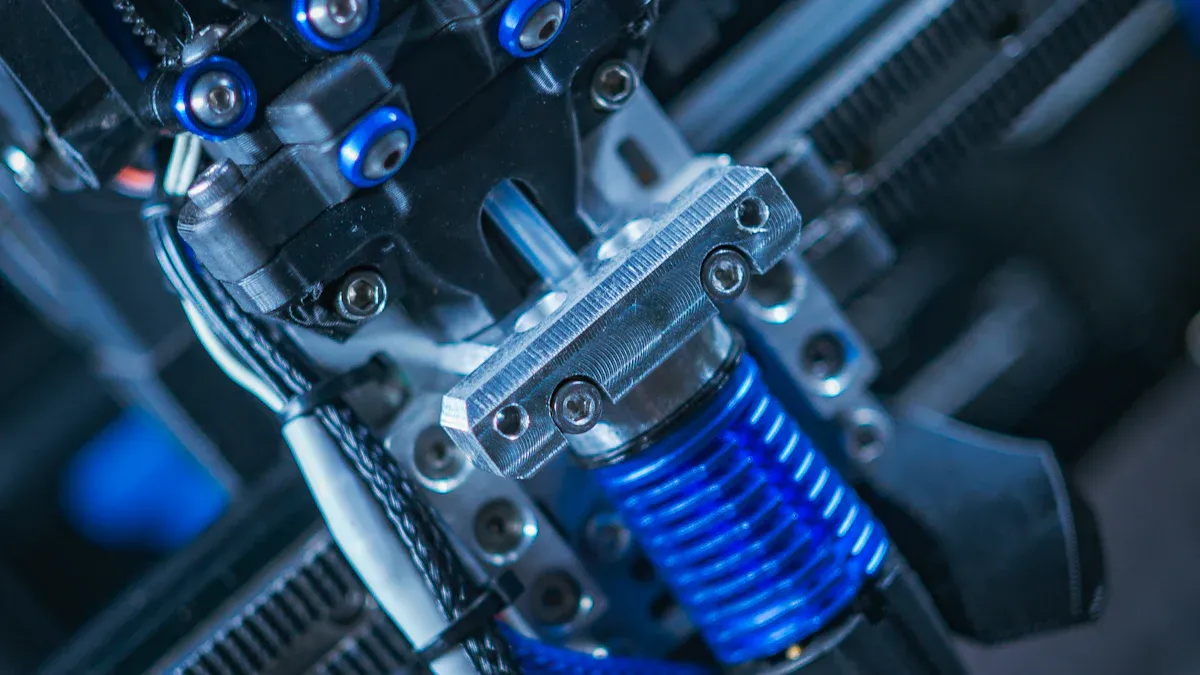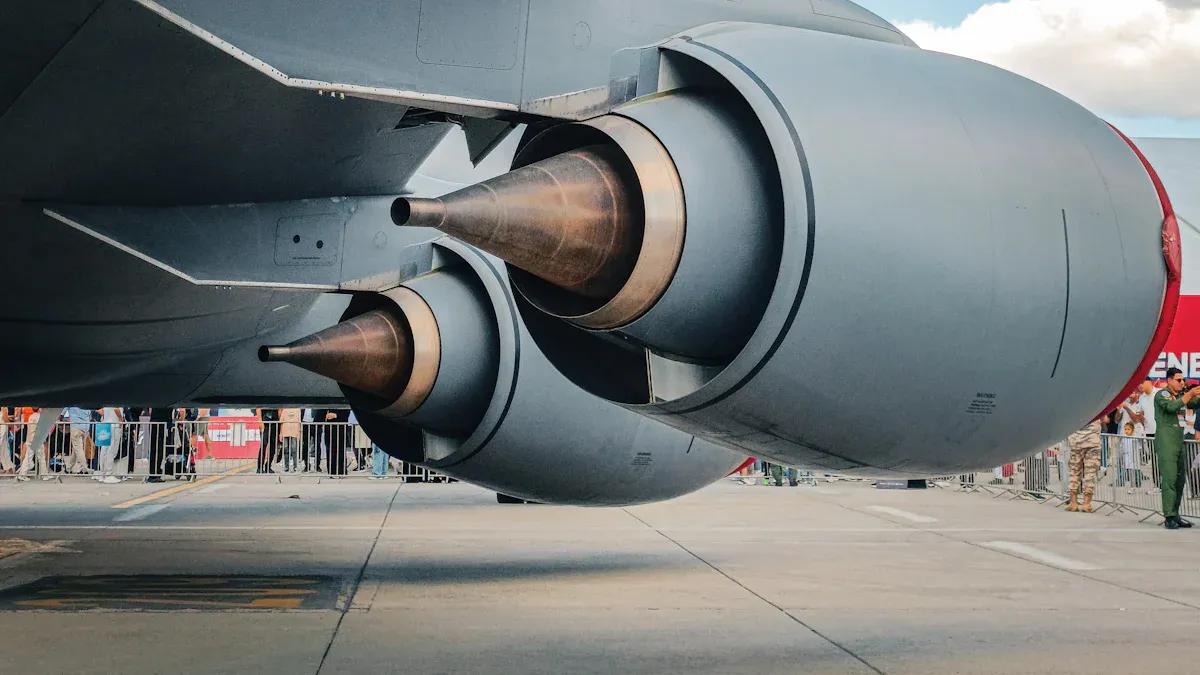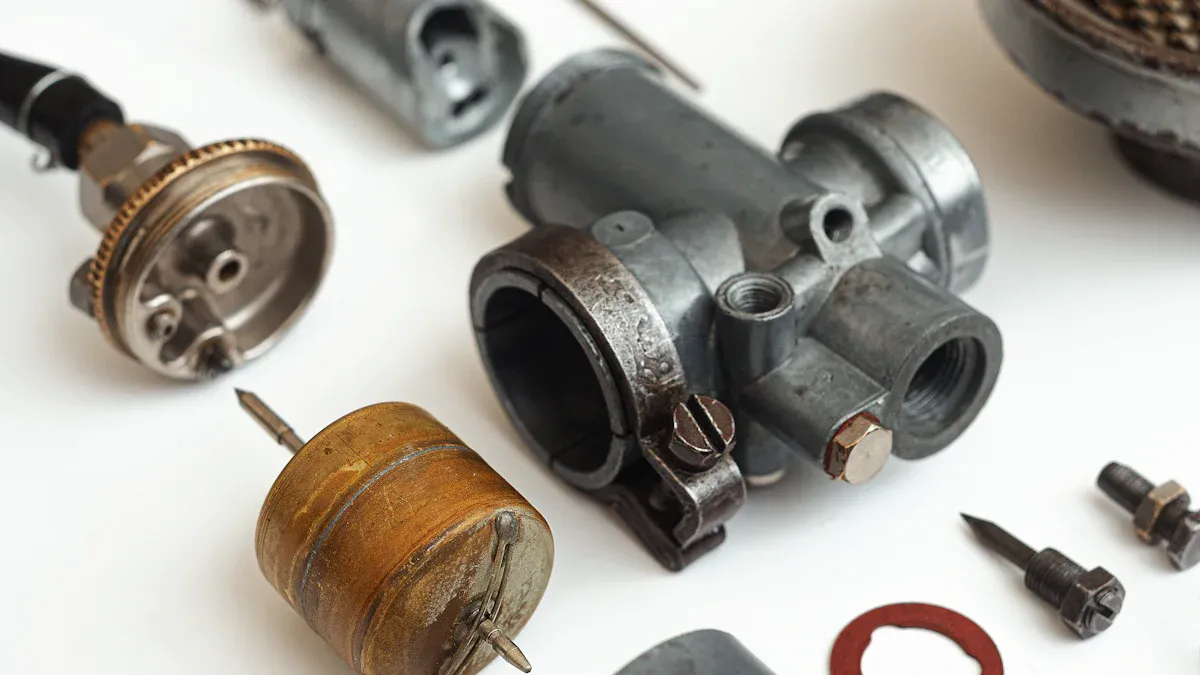
The automotive and aerospace industries are primary clients of powdered metal parts manufacturers. These sectors choose powder metal for its unique ability to produce complex, high-strength parts with minimal waste, creating net-shape components efficiently. Key applications range from automotive engine parts to critical aerospace hardware. The powder metallurgy market is growing steadily, reflecting its value and reliability across a wide range of applications.
| Attribute | Value |
|---|---|
| Estimated Market Size (2025) | US$ 11,630.2 Million |
| Projected Market Value (2032) | US$ 19,169.8 Million |
| Value CAGR (2025 to 2032) | 7.4% |
The Automotive and Aerospace Industries: A Foundation of Strength

The automotive and aerospace industries are pillars of modern engineering. They demand components that offer exceptional strength, precision, and reliability. Powder metallurgy provides a powerful solution, enabling the production of complex parts that meet these rigorous standards. These sectors consistently turn to powder metal for its unique manufacturing advantages and superior performance outcomes.
Automotive Powder Metal Applications
The automotive sector uses a wide array of powder metal parts to enhance vehicle performance and efficiency. Many critical engine and transmission components are made using this technology. Common automotive powder metal applications include:
- Engine elements like connecting rods and main bearing caps.
- Transmission parts such as compound AGMA 8 gears and clutch rotors.
- Components for four-wheel drive systems, including planet gears made from HI-IMPAC copper-infiltrated sintered steel.
These applications demonstrate the versatility of powder metal in creating durable, high-precision automotive parts.
Aerospace and Defense Applications
In the aerospace sector, safety and performance are paramount. Powder metallurgy delivers materials for high-performance applications where failure is not an option. Specialty steels and superalloys are essential for these demanding applications. For example, nickel-based superalloys like Rene95 and IN 100 are used for turbine disks, while titanium alloys form compressor blades. The defense industry also leverages innovative powder metal applications. Some companies use binder jet 3D printing to create advanced thermal protection systems, reducing lead times for critical aerospace components.
Did You Know? 💡 Powder metal allows for the creation of specialized alloys like FeCrMoWMnSiBC, a spherical iron-based powder. Its high strength and thermal stability make it ideal for aerospace parts like landing gear and turbine components.
Why These Sectors Rely on Powdered Metal
The automotive and aerospace industries rely on powder metal for two primary reasons: cost efficiency and enhanced performance. The process creates near-net-shape parts, which means they are produced very close to their final dimensions. This capability drastically reduces waste, with over 97% of the raw material being used in the final product. It also minimizes the need for expensive and time-consuming secondary machining.
Furthermore, powder metal enables significant weight reduction. An aluminum powder metal sprocket, for instance, can be 50% lighter than a traditional sintered iron one. This weight savings improves fuel efficiency, a critical goal for both the automotive and aerospace industries. Expert powdered metal parts manufacturers deliver these benefits, making powder metallurgy an indispensable technology.
Medical and Dental Sectors: Precision and Biocompatibility
The medical and dental fields demand components with extreme precision, complex geometries, and complete biocompatibility. Powder metallurgy is an ideal manufacturing solution, delivering high-performance parts that meet these strict requirements. The process enables the creation of intricate medical devices and implants with superior material properties. These powder metal applications are critical for advancing patient care and treatment outcomes.
Key Medical Powder Metal Applications
Powder metal technology, particularly Metal Injection Molding (MIM), produces a variety of essential medical components. This method is perfect for high-volume production of small, complex parts with consistent quality. Key applications of powder metal include:
- Surgical instruments with sophisticated shapes
- Components for artificial joints and pacemakers
- Implantable parts requiring high density and strength
Powder metallurgy creates parts with excellent mechanical properties and smooth surface finishes. This reduces the need for secondary machining and minimizes material waste, making it a cost-effective choice for medical device manufacturers.
Dental and Orthodontic Applications
In dentistry, powder metal excels at producing small, highly precise parts. Orthodontic brackets, for example, are now commonly made from titanium and cobalt-chromium alloys using MIM. This manufacturing technique allows for intricate designs that improve patient comfort and treatment effectiveness. The powder metal process ensures that these small parts have the necessary strength and corrosion resistance for long-term use. The ability to create complex geometries is crucial for these specialized applications.
The Need for Specialized Materials
Medical and dental parts must be biocompatible to prevent adverse reactions with the human body. Powder metallurgy uses specialized materials that offer excellent performance and safety. Titanium and its alloys remain a top choice for orthopedic implants due to their strength and ability to integrate with bone.
Note: All materials used in medical devices must meet strict industry standards, such as ASTM F2885 for MIM Titanium alloys and the ISO 10993 series for biocompatibility testing.
| Material | Common Alloys | Major Applications |
|---|---|---|
| Titanium Alloys | Ti-6Al-4V, Ti-6Al-7Nb | Dental implants, joint replacements |
| Cobalt-Chromium | Co-Cr-Mo | Artificial joints, heart valves |
| Stainless Steel | 316L, 17-4PH | Surgical tools, fracture plates |
These advanced powder metal materials ensure the long-term reliability and safety of medical and dental applications.
Industrial Machinery and Tools: Durability for Demanding Jobs

Industrial machinery and power tools operate in high-stress environments that demand exceptional durability. Powder metal parts provide the strength and resilience needed for these demanding jobs. Manufacturers use powder metal to produce components that withstand constant friction, high loads, and intense vibration, ensuring long-term performance and reliability.
Power Tools and Heavy Equipment
The performance of modern power tools and heavy equipment relies heavily on the quality of their internal components. Powder metallurgy delivers complex, high-strength parts essential for their operation. Sinter-hardened steel materials offer remarkable wear resistance, making them ideal for these applications. This inherent durability extends the tool’s life even in harsh conditions. Common powder metal parts include:
- Hammer mechanisms and trigger mechanisms
- Planetary gear drives and internal gearing systems
- Ratchets, pawls, and rotating couplers
These components showcase the versatility of powder metal in creating robust parts for high-performance tools.
General Industrial Machinery Components
Beyond power tools, powder metal applications extend to a wide range of general industrial machinery. One of the most significant powder metal applications is the creation of self-lubricating bearings. The powder metallurgy process produces parts with a porous internal structure. Manufacturers impregnate this structure with oil, which is released during operation to reduce friction and wear. This innovation is critical for machinery where regular maintenance is difficult, improving both efficiency and longevity. These unique applications demonstrate how powder metal solves complex engineering challenges.
Advantages for High-Volume Production
Powder metal is exceptionally cost-effective for high-volume manufacturing. The process creates near-net-shape parts, minimizing material waste and secondary machining. This efficiency becomes a major financial advantage as production quantities increase.
| Factor | Powder Metallurgy | CNC Machining |
|---|---|---|
| Material Waste | Approximately 3% | Up to 50% |
| Suitability | Best for high-volume production | Best for low-volume production |
For large-scale manufacturing, choose Powder Metallurgy. For prototypes or small batches, CNC Machining offers better flexibility.
Furthermore, the sintering process ensures remarkable consistency. Tightly controlled furnace temperatures and atmospheres minimize distortion, ensuring every part meets precise dimensional tolerances. This reliability is crucial for producing thousands of identical parts with consistent quality and durability.
Consumer Products: From Electronics to Home Appliances
Powder metal parts are not just for heavy industry; they are essential components in many everyday consumer products. From the smartphone in your pocket to the appliances in your home, powder metallurgy delivers the complex, reliable parts that modern life depends on. This technology helps manufacturers create innovative products with excellent performance.
Applications in Consumer Electronics
Many people are surprised to learn that powder metal is crucial for modern electronics. The tiny, intricate components inside devices like smartphones and laptops require materials with special properties. Manufacturers use powder metal to create these specialized parts.
- Tantalum, a heat-resistant powder, is used to make capacitors that control electrical flow. These are found in virtually all smartphones, laptops, and gaming consoles.
- Boron, which can be processed as a powder, helps create heat-resistant glass covers, improving the high-temperature stability of laptops.
These applications show how powder metal enables the production of advanced electronic devices.
Lawn, Garden, and HVAC Systems
Outdoor equipment and HVAC systems must withstand demanding conditions, from harsh weather to constant vibration. Powder metal solutions provide the necessary durability and corrosion resistance for these tough applications. The inherent properties of powder metal parts make them ideal for high-stress environments. This makes powder metal applications a reliable choice for gears, structural components, and other parts in lawnmowers, leaf blowers, and air conditioning units.
Balancing Cost and Complex Geometry
One of the greatest strengths of powder metallurgy is its ability to produce complex shapes cost-effectively. This process allows designers to combine multiple features into a single component, which simplifies assembly and reduces production time.
Powder metallurgy can convert a complex, multi-piece assembly into a single, integrated part. For example, an appliance hinge can be formed in one step with all its holes, mounting plates, and edge details included. This eliminates the need for extra machining and speeds up final assembly.
This capability to create intricate 3D shapes in a single pressing makes powder metallurgy an invaluable tool for manufacturers seeking to balance complex designs with efficient, high-volume production.
How Top Powdered Metal Parts Manufacturers Add Value
Leading powdered metal parts manufacturers provide more than just components; they deliver comprehensive engineering solutions. They partner with clients to optimize designs, ensure quality, and develop custom parts. This value-added approach is critical for industries seeking high-performance and cost-effective solutions.
Advanced Technical and Engineering Support
Expert manufacturers offer advanced technical support to refine part designs for optimal performance. They use powerful simulation software to predict how a component will behave under real-world stress.
Engineering Insight 💡 Finite Element Analysis (FEA) platforms like PanX help engineers evaluate designs for metal 3d printing. This software can predict and compensate for distortion, ensuring the final part meets exact specifications. These advanced solutions improve the entire metal additive manufacturing process.
This digital testing allows for the creation of innovative solutions without the cost of physical prototypes. It is a key part of modern powder metallurgy, enabling better and more reliable parts. These engineering solutions ensure every design is optimized before production begins.
Comprehensive Quality Control and Testing
Rigorous quality control is essential for all powder metal parts. Manufacturers perform a series of tests to guarantee every component meets strict standards for strength and durability. This commitment to quality ensures superior performance in demanding applications. Common testing solutions include:
- Density Verification: This test confirms the part’s internal structure. It directly impacts mechanical properties and is a key indicator of quality.
- Hardness Testing: Methods like Rockwell or Vickers testing measure the material’s resistance to wear and abrasion.
- Dimensional Inspection: High-precision tools, including Coordinate Measuring Machines (CMMs), verify that each part’s dimensions match the design specifications perfectly.
These quality solutions confirm the integrity of every powder metal component.
Custom Solutions with OEM and ODM Services
Top manufacturers provide custom solutions through Original Equipment Manufacturer (OEM) and Original Design Manufacturer (ODM) services. They collaborate with clients to create unique powder metal parts tailored to specific needs. This partnership drives the development of innovative solutions for complex challenges. As future trends in powder metal technology emerge, including advances in metal 3d printing and sustainable manufacturing practices, these custom solutions become even more valuable. This collaborative approach to powder metallurgy delivers innovative solutions that push industries forward.
The automotive and aerospace industries depend heavily on powdered metal parts manufacturers for critical components. This reliance is driven by the need for high-strength, complex parts produced with superior efficiency and cost-effectiveness. As technology advances, the partnership between industries and expert manufacturers like Max becomes essential for developing next-generation products.
Future trends in powder metal technology are already shaping the market. These include:
- New alloys for lighter, stronger automotive parts.
- Additive manufacturing for rapid prototyping and complex designs.
This evolution in future trends in powder metal technology makes expert powdered metal parts manufacturers indispensable partners for innovation.
FAQ
What is powder metallurgy?
Powder metallurgy is a manufacturing process. It involves compressing metal powders into a desired shape and then heating them in a controlled furnace. This heating process, called sintering, bonds the particles together to create a solid, high-strength part.
What are the main benefits of using powder metal parts?
Powder metal parts offer several key advantages. The process creates complex, near-net-shape components with minimal material waste (over 97% utilization). It ensures high-volume production consistency, excellent strength, and significant cost savings compared to traditional machining methods.
Which materials are commonly used in powder metallurgy?
Manufacturers use a wide range of materials. Common choices include iron and steel alloys, stainless steels, copper, and aluminum. Specialized materials like titanium alloys, cobalt-chromium, and superalloys are used for demanding medical and aerospace applications.
How does powder metallurgy reduce manufacturing costs?
Powder metallurgy forms parts very close to their final dimensions. This near-net-shape capability drastically reduces the need for expensive secondary machining. It also minimizes material waste, which lowers overall production costs, especially for high-volume orders.
